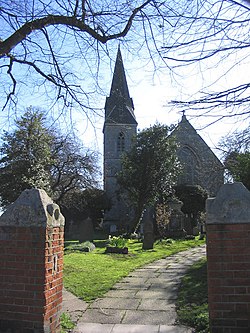Cranham
| Cranham | |
| Essex | |
|---|---|
 All Saints Church, Cranham | |
| Location | |
| Grid reference: | TQ575875 |
| Location: | 51°33’43"N, -0°16’5"E |
| Data | |
| Post town: | Upminster |
| Postcode: | RM14 |
| Dialling code: | 01708 |
| Local Government | |
| Council: | Havering |
| Parliamentary constituency: |
Hornchurch and Upminster |
Cranham is a village in Essex, at the edge of the metropolitan conurbation, from which it has not entirely escaped, though it does mark the eastern edge of the urban sprawl. The village has an extensive built-up area to the north and a low density conservation area to the south surrounded by open land. The economic history of Cranham is characterised by a shift from agriculture to housing development.[1]
Name
Cranham is recorded in the Domesday Book of 1086 as Craohv and in 1201 as Craweno.[2] It is the Old English 'crawe hoh', meaning ‘Crow Hill’; a ‘hoh’ being specifically a spur of land or heel-shaped hill.[2]
During the Middle Ages, and until around the 15th century, the village was also known as Bishop's Ockendon because a large part of its area was owned by the Bishop of London.[1]
Churches
All Saints parish church was rebuilt in 1873 and is a grade II listed building. James Oglethorpe, the first governor of Georgia, now one of the United States of America, is buried with his wife at the centre of its chancel.[3]
There is a second church, named St Luke's, further north on Front Lane.[4]
History
Cranham in the Anglo-Saxon period contained two manors; Ockendon (Wochenduna) and Cranham (Crawenho).[1]
The parish is recorded in 1086 as being heavily wooded, supporting an agrarian way of life.[1] Forest clearance was well advanced by the 15th century, with an increase in population and arable land; and there was a windmill in Cranham.[1] Cranham lay on brick earth and this gave rise to the Cranham Brick and Tile Company which was in operation from 1900 to 1920.[1] Drury has suggested that early trade was with the nearby villages of Romford and Hornchurch and with London by way of the River Thames at Rainham.[5]
As part of the suburban growth of south-western Essex in the 20th century, Cranham significantly increased in population.
In the 17th and 18th centuries manorial homes, including Cranham Hall, became attractive properties for merchants from the City of London.[5] Initial attempts to expand the suburban estates from Upminster in the early 20th century ran into problems because of the lack of water supply.[1] In 1922 sewage works for Upminster and Cranham were opened in Great Warley. In the 1930s land was used to develop some council housing and following the sale of the Benyon estate the pace of new building quickened. Cranham's location on the very edge of London's urban sprawl is explained by the halting effect on suburban house building of the introduction of the Metropolitan Green Belt and Second World War.[5][1] Thereafter building took place within the area bounded by the Southend Arterial Road in the north and St Mary's Lane in the south; and there were 615 council houses built by 1971.[1]
Economy

The village has several short parades of shops; the largest on Front Lane
A number of commercial businesses are found here, centred around the A127 Southend Arterial Road including a wholesale butcher, mushroom cultivator, caravan sales, and a sports equipment supplier. There are a limited number of hospitality venues, including pubs and a popular tandoori restaurant.
Transport

Front Lane is the main road through Cranham and runs north to south, connecting with the A127 road in the north. Half a mile northeast is a junction with the M25 motorway.
The Upminster depot of the London Underground's District Line is at Cranham.[6] The nearest London Underground station is at Upminster, just thre quarters of a mile to the west.
The London-Tilbury-Southend Line of the National Rail network passes through the area in two places, with the nearest station also at Upminster.
Sights about the village
The area around the church forms a conservation area.[7]
Cranham Hall, the former manor house, is a grade II listed building.
Big Society
Community associations:
- The Cranham Community Association operates a broad range of sporting, self-improvement and hobby activities at Cranham Community Centre on Marlborough Gardens.
- Cranham Social Hall, with a capacity of 100, is separately operated by the Front Lane Community Association, and provides a limited range of activities
The main cultural and entertainment facilities of the borough are located in Hornchurch and Romford.
Outside links
| ("Wikimedia Commons" has material about Cranham) |
References
- ↑ 1.0 1.1 1.2 1.3 1.4 1.5 1.6 1.7 1.8 A History of the County of Essex: Volume 7. Parishes: Cranham - Victoria County History
- ↑ 2.0 2.1 Mills, D. (2000). Oxford Dictionary of London Place Names. Oxford.
- ↑ All Saints', Cranham
- ↑ St Luke's, Cranham with Moor Lane Church
- ↑ 5.0 5.1 5.2 The Paul Drury Partnership (February 2007). "Cranham Conservation Area: Character Appraisal and Management Proposals". Havering London Borough Council. http://www.havering.gov.uk/CHttpHandler.ashx?id=7554. Retrieved 23 February 2010.
- ↑ "Upminster depot celebrates 50th anniversary". Transport for London. 24 August 2009. http://www.tfl.gov.uk/static/corporate/media/newscentre/archive/12433.html. Retrieved 23 February 2010.
- ↑ "Cranham Conservation Area". Havering London Borough Council. 6 February 2006. http://www.havering.gov.uk/CHttpHandler.ashx?id=2359&p=0. Retrieved 23 February 2010.